Thoughts
Design Me, Kenyalang 1: Background
We have a new book! And design-wise it’s similar to our first book, but also very different. I want to talk a little bit about the design of this book: how it came about, some of the things that we imagined, and the different places that this project has gone and will go.
The first thing I did was make a mistake. I heard about the book from Jenny who had been told about it by Pauline Fan, the translator. And my first understanding of the book was that it was an English translation of a Malay version of an Iban original, some sort of weird double translation. I had not actually seen any of the text at this point. But the image that came to my ignorant mind was of something layered, of moving through different levels of language to reach the meaning of the text. And this made me think of the exciting part of encyclopedias when I was a child, the transparent pages that you can layer to show the various anatomical systems of the body and how they fit together:
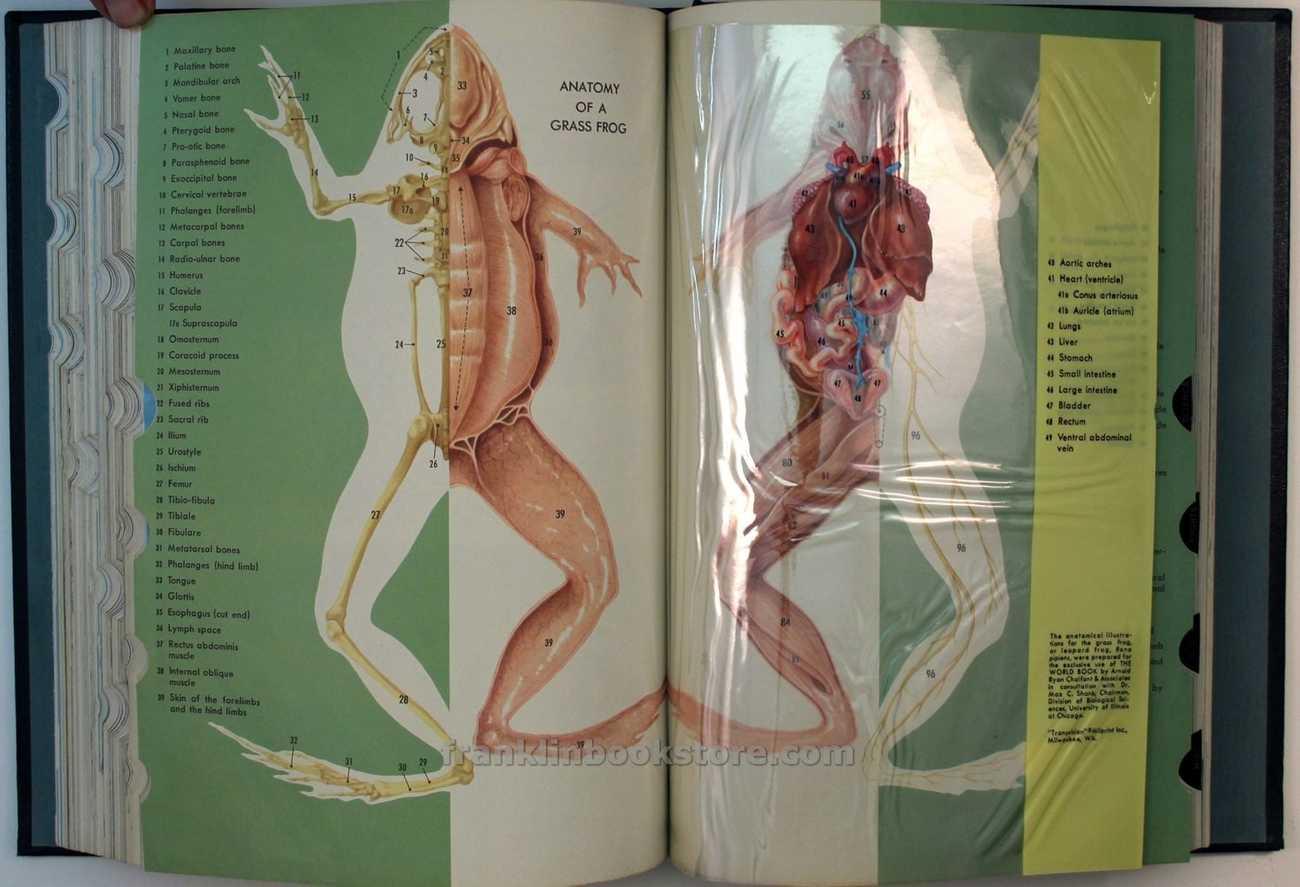
Different layers of the anatomy of a grass frog in a 1965 World Book Encyclopedia for children.
What we would do, I thought, is publish three texts that would be on top of each other – we’d find some printer that could make half the pages out of cellophane, and the English page would overlay the Malay page which would overlay the Iban page. This idea, of course, bears no relation at all to the actual book. The actual text of the original is mostly in Malay, but with a lot of words and phrases from not only Iban, but many other indigenous languages of Borneo. (The keen-eyed might have noticed that this website used to describe the book as “translated from Malay and Iban,” though it’s moved, mostly to “translated from Malay”. Maybe it still says that somewhere?) And a lot of (but not all of) those words appear in the English text as well. So I shelved the idea of layering, though that’s something that will come back in later.
I started by falling back on putting the Malay text and English text side by side. Yes, this should be read as a bit of a cop-out in the light of how we threw out all the rules of poetry in facing-page translation when we made Camouflage. But a tenet of design is that one follows the rules until you’re good enough to break them. And putting the texts side by side actually is interesting: in a lot of these spreads what you notice with Tell Me, Kenyalang isn’t what’s different between the original and the translation but the sheer number of words – mostly those from the indigenous languages – that are shared between them. This isn’t what you’d expect from two languages that don’t share a lot of cognates. And you have a sense – even if you don’t speak a word of Malay – which words are those from indigenous languages, because most of them are italicized.
Maybe it is worth talking for a little bit about italic and Roman type. Roman type – the upright type that most things are in – is more of a mutt than its name suggests. The capital letters, of course, come from the inscriptions of the Roman Empire: it’s the lettering of power. But lower-case letters don’t come from Rome at all: they were only invented by monks in the Middle Ages to save space when copying manuscripts. Sticking the two together makes a nice rhythm; too much lowercase becomes claustrophobic, perhaps what might be expected from its monastic origins. Italic type comes from fifteenth-century Venice: it imitates not the capitals of imperial inscriptions or the lowercase of monks but rather the elegant handwriting of northern Italy. It is a design based on aesthetic pleasure rather than on the demands of power or religion. Aldus Manutius saw italic as a superior alternative to Carolingian miniscule and set whole books in it, though this is not something one sees done very often any more. Illustrations:
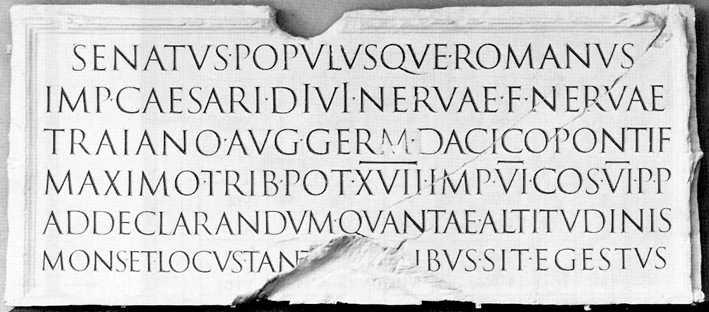
The text on Trajan's Column in Rome, carved in stone 1900 years ago, is basically identical to the way we use upper-case letters today.
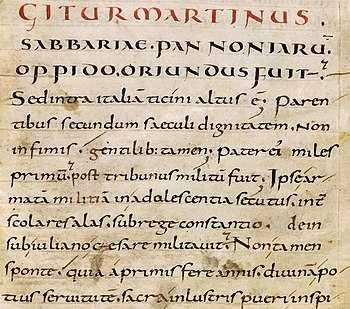
Handwritten lowercase (“Carolingian miniscule”) from the middle ages.
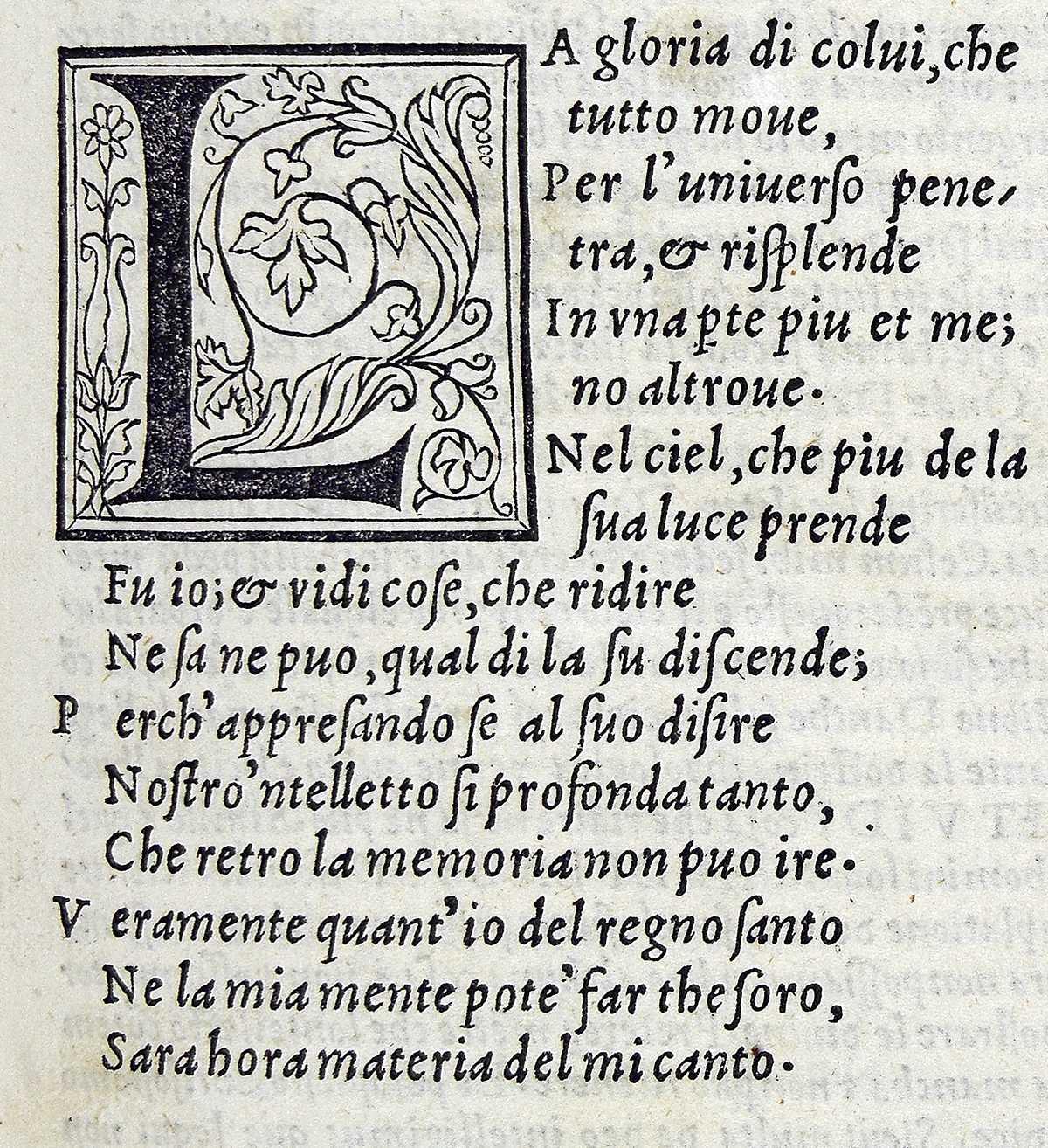
Type designed by Francesco Griffo in Venice around 1500. Note that he’s using what looks like lower-case italics with Roman capitals.
Viewed historically mixing Roman and italic type as we do today is thus a sort of cultural mixing – one suspects the inventors wouldn’t have wanted anything to do with one another if they had any choice in the matter. But generally the usage in English has been to set foreign words in italic: to set them off, to mark them as being apart, something not quite assimilated. And this is maybe appropriate for Kulleh Grasi’s Malay, which is full of other cultures – like the cells of our bodies, which contain mitochondria, tiny energy factories that were once free-living bacteria until hundreds of millions of years ago they took up residence in the cells of our ancestors.
But I digress. Malay, it should be noted, is mostly written in Roman script today; that reflects British colonialism. (The Dutch colonial system, which was running much of what’s now Indonesia, had very different language policies, but that’s a subject for another time.) Before the British, most Malay would have been written in Jawi, a modified Arabic script; the British imposed Roman scripts on Malay, and that’s largely what’s used today. And the Dayak languages are from outside of the Muslim Malay world, though they did engage with it. The point of all of this is that even before we start thinking about what the words means, by just looking at the visual symbols that comprise them, there’s a huge amount of historical baggage that, consciously or not, is going to impact the way we read.
So we have a text that consists of other kinds of texts, which have complex – and very loaded – interrelationships. Next time: we’ll go through how this comes out in the text.
Singapore Writers Festival Wrap-Up
Kulleh Grasi, Pauline Fan, and Kulleh's band Nading Rhapsody all appeared at the Singapore Writers Festival this year. Some photos and videos for those who couldn't make it:
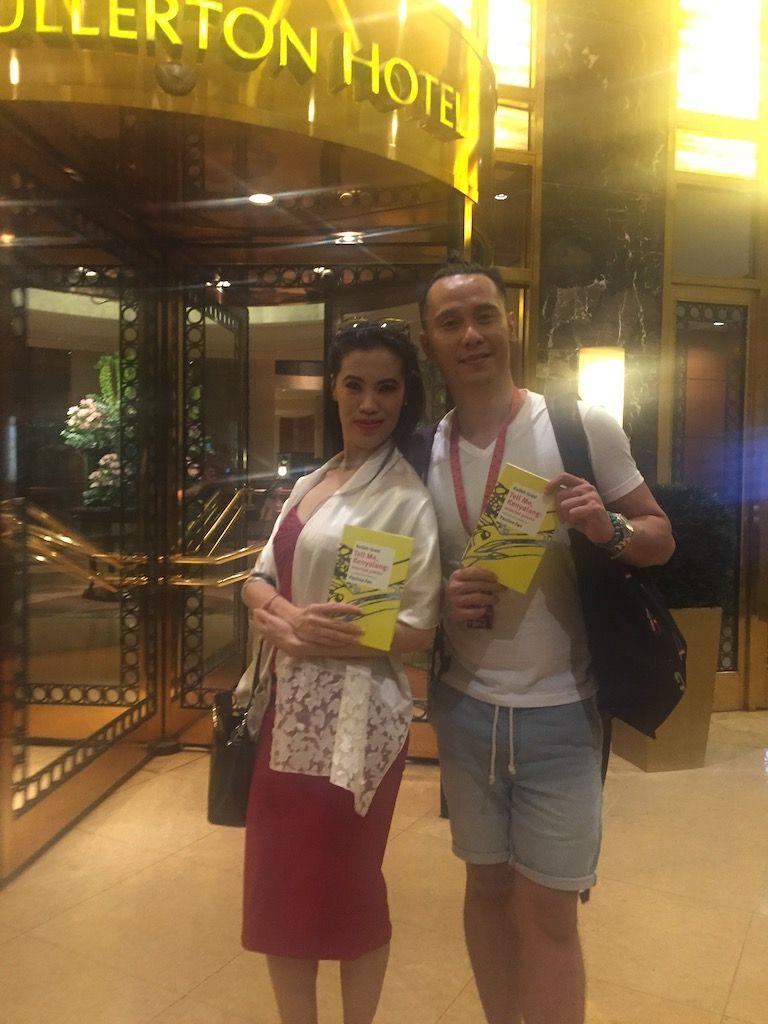
Translator Pauline Fan and poet Kulleh Grasi seeing the book for the first time.
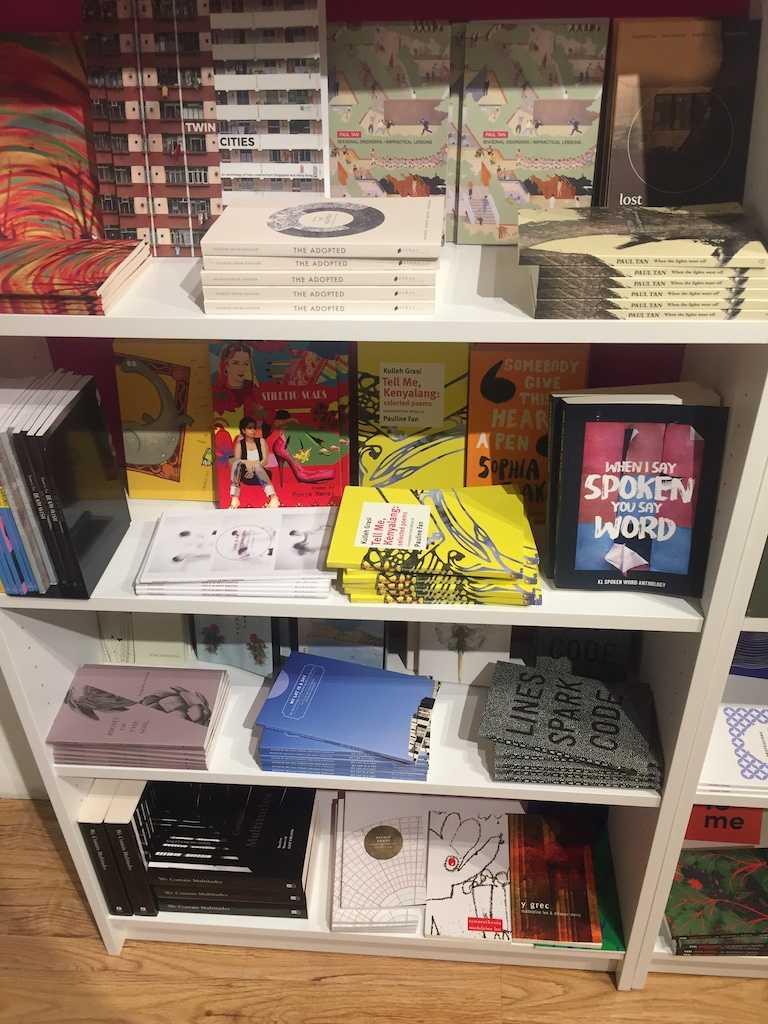
Our book is real! And available in the festival bookstore.

Pauline Fan on a panel. It is impossible to make a panel look interesting, and the lighting of this one made it look like a prison interrogation.
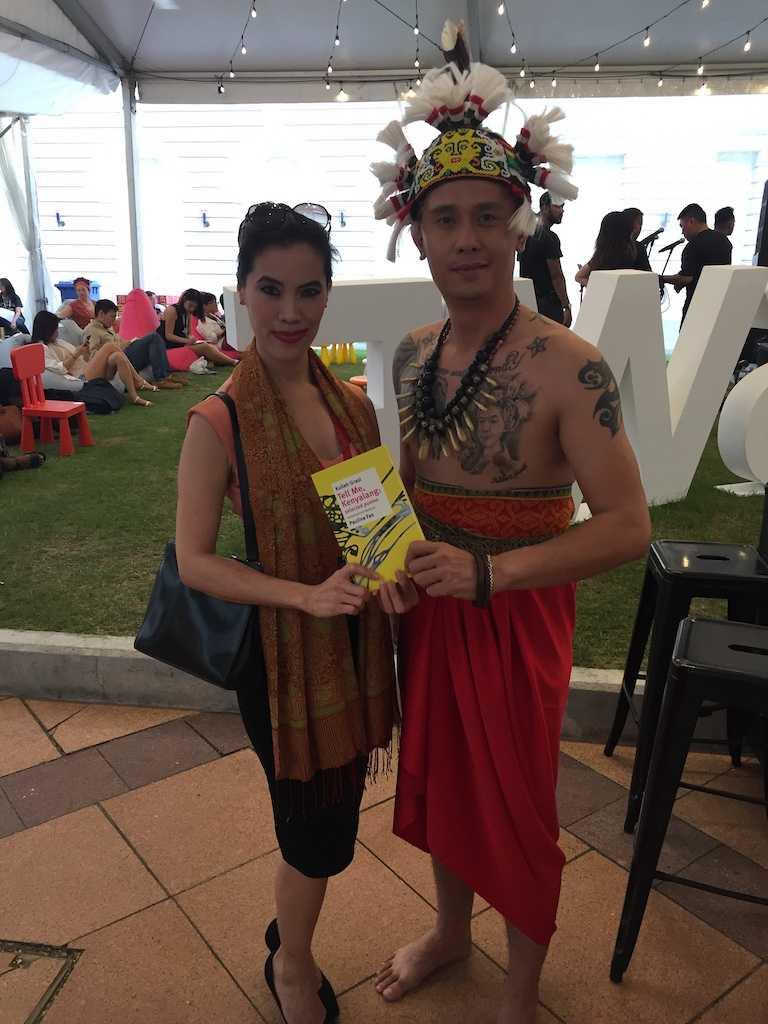
Poet and translator and book, right before Nading Rhapsody's first performance.

Kulleh Grasi on a panel.

Kulleh Grasi being interviewed by Singaporean television after the performance – we should figure out whether this ever aired! Also Kulleh was interviewed about the book on Malaysian television last week, which we should also find.

Poet and translator after the show.
Tell Me, Kenyalang is out!
Our second book, Kulleh Grasi’s Tell Me Kenyalang, translated by Pauline Fan is out today! If you don’t already have a copy, you can get one from our store.
Are you feeling unsure about buying poetry sight unseen? If you visit the book page for the month of November, you can read the book yourself! Or you will if you keep visiting that page: for every day of the month of November, we’ll post a poem from the book – the first poem on the 1st, the last poem on the 30th. The cheap (and dutiful) can read the book that way! If you don’t think you can reliably visit that page every day of the month of November, you are more than welcome to visit the store, where you can buy a copy of the print version and read the whole thing, along with Pauline Fan’s introduction.
(And consider becoming a subscriber? If you were a subscriber, you would have been able to go to our secret subscribers’ page a few weeks ago and read the whole book (and the introduction!) online. Subscribe now and you can still get in – and you’ll get our next book, which we’re not quite ready to announce, but we will very soon.)
Tell Me, Kenyalang at the Singapore Writers Festival
We have some events coming up for Tell Me, Kenyalang if you happen to be in Singapore! Poet Kulleh Grasi, translator Pauline Fan, and Kulleh Grasi’s band, Nading Rhapsody, are going to be appearing at the Singapore Writers Festival. Here’s the schedule of events:
- Saturday 2 November, 5 p.m.–6 p.m.: Pauline Fan appears as part of a panel entitled SWF Translation Roundtable with Babak Tabarraee, Lian Hai Guang, and Shelly Bryant.
- Saturday 2 November, 6:30 p.m.–7 p.m.: Nading Rhapsody performs at the SWF POP Stage
- Sunday 3 November, 10:30 a.m.–noon: Kulleh Grasi appears on a panel entitled The Death of Languages with Louis-Jean Calvet, Caryl Lewis, and Waubgeshig Rice
- Sunday 3 November 7:30 p.m.–8:30 p.m.: Pauline Fan appears as part of Navigating the SEA with Joshua Ip, Martin Villanueva, and Christine Chia.
- Sunday 3 November, 8 p.m.–9:30 p.m.: Nading Rhapsody appears in A Spotlight on Indigenous Voices with Wab Kiew, Melanie Mununggurr-Williams, Moe Clark, and Annaliza Bakri.
The Nading Rhapsody performance is free; other events are ticketed. While the price per event seems ludicrously high, you can buy a Festival Pass for SG$20 if you buy before the end of September; after that, it’s SG$25.
Tell Me, Kenyalang is out soon!
As mentioned, we’re putting the finishing touches on Kulleh Grasi’s Tell Me, Kenyalang, which will be out at the beginning on November. But we have a handful of blurbs that we can share with you now:
Kulleh Grasi has channeled “the rhythms from sebayan, / qasidahs from bunian” to bring us the “fragrance of paradise” of his native Sarawak, the place at the heart of his akui-self that springs forth from the Sea Dayak longhouse community (“leaf of the world”) like a Kalang deer and suffuses his poetry with Iban myths, sensual beauty, ancestral bonds, dreams, and the songs of trees, birds, river, and sun-rain. Pauline Fan’s finely woven pua-kumbu translation comes to us as a blessing from kenyalang’s beak.
—Jeffrey Yang
If you need a reason to believe in the value of translation, here are thirty. Pauline Fan’s versions of Kulleh Grasi’s poems teach Malay and Iban to English. Translation changes us, into and out of languages, thankfully, because without it we might not know what it is like to be young and full of myth, music, and meaning in Malaysia. This multilingual voice sounds like it’s from right now, because it is.
—Paul Legault
The vitality of poetry hides in its secret veins, from which the unordinary — words, images, dreams — spout and sparkle.
Kulleh Grasi’s verses affirm this and Pauline’s translation gives them a poetic rebirth.
There are many instances of enchantment in this collection of poems. As I see it, in Kulleh Grasi’s pieces Malay poetry finds its “minor literature” (in the Deleuzian sense)— as they create idioms that slip away from the confine of identity (“deterritorialized”) and are linked with issues of finding a voice within a language that is both alien and familiar. The poems stammer, as it were, and disrupt the typically linear, narrative-bound verses in mainstream Malaysian poetry.
What a gift.
—Goenawan Mohamad
Women in Translation Month
It turns out that it was Women in Translation Month in August, though we were too busy putting the finishing touches on Tell Me, Kenyalang and didn’t notice until the month was almost over. But! Women in Translation Month never ends at Circumference, or at least it goes on for another month. For all of September, you can buy Camouflage by Lupe Gómez for the reduced price of $13! Click here to visit our store and pick it up if you haven’t already – or buy another copy for a friend?
Snapshots from Work in Progress
The electronic version of Camouflage has taken longer than we expected it to! But it's on the way, and here are a couple of screenshots from the app in development:
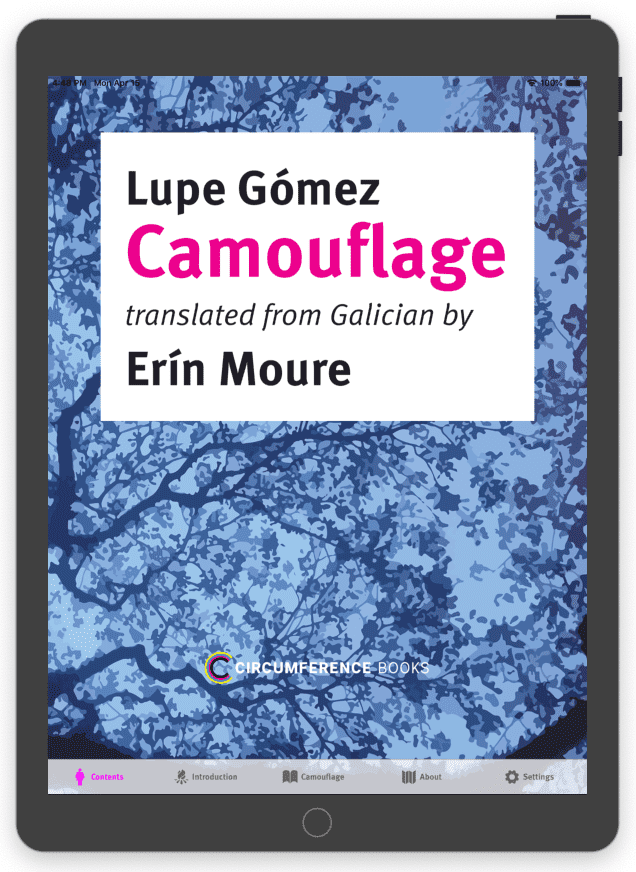
The main screen of the app in an iPad simulator.
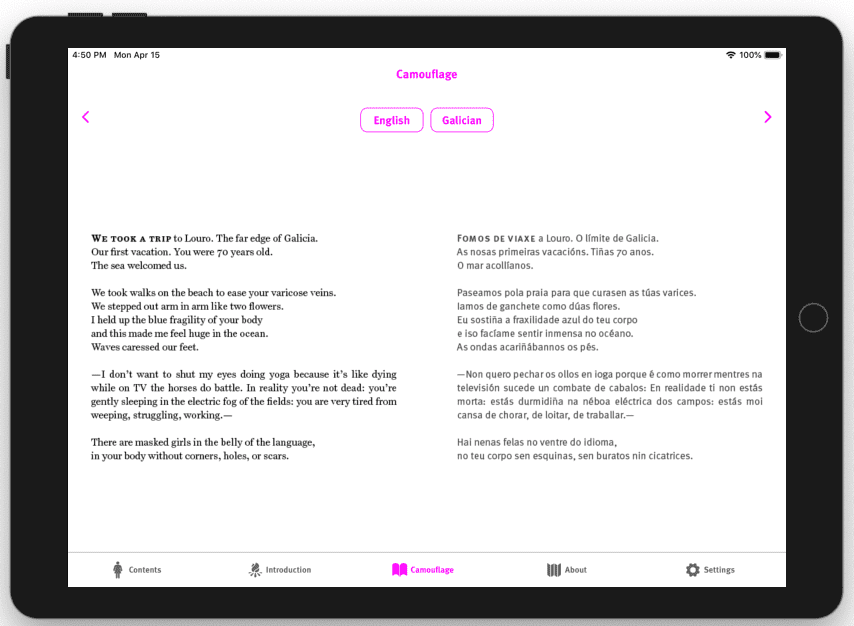
A spread from the book. Pressing the "English" and "Galician" buttons let you choose which languages you want to read in.
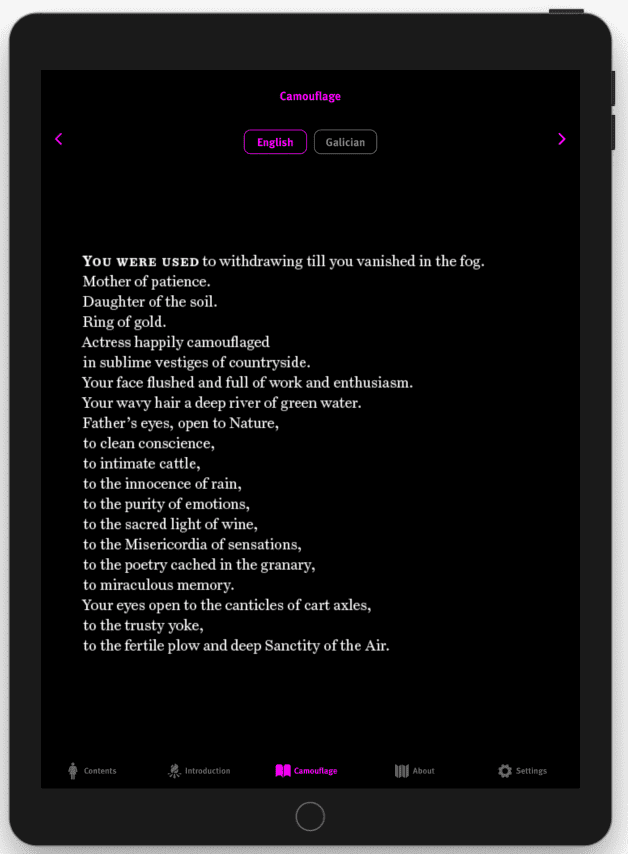
Just an English poem, in dark mode so you can read at night.

Erín Moure's introduction, in landscape mode.
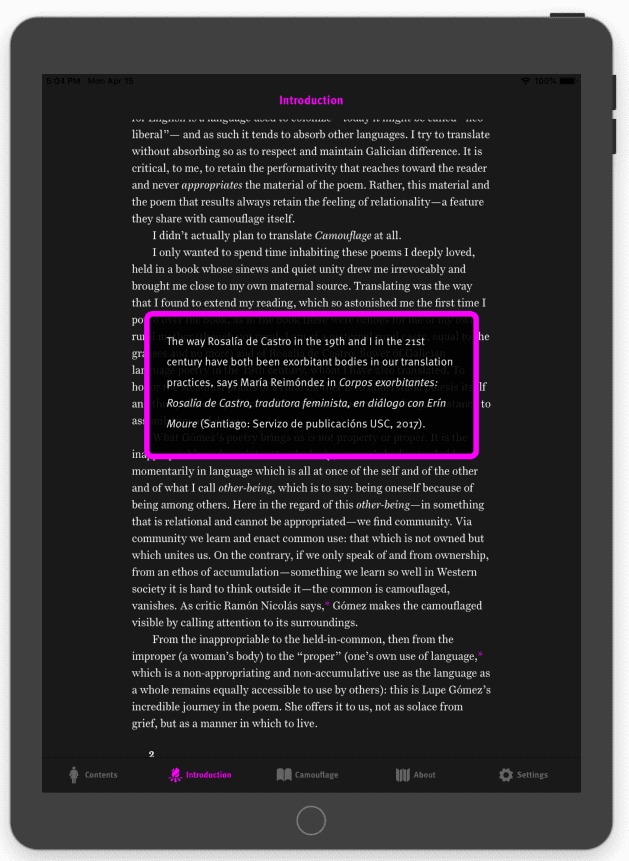
What about the footnotes? you ask. Footnotes!
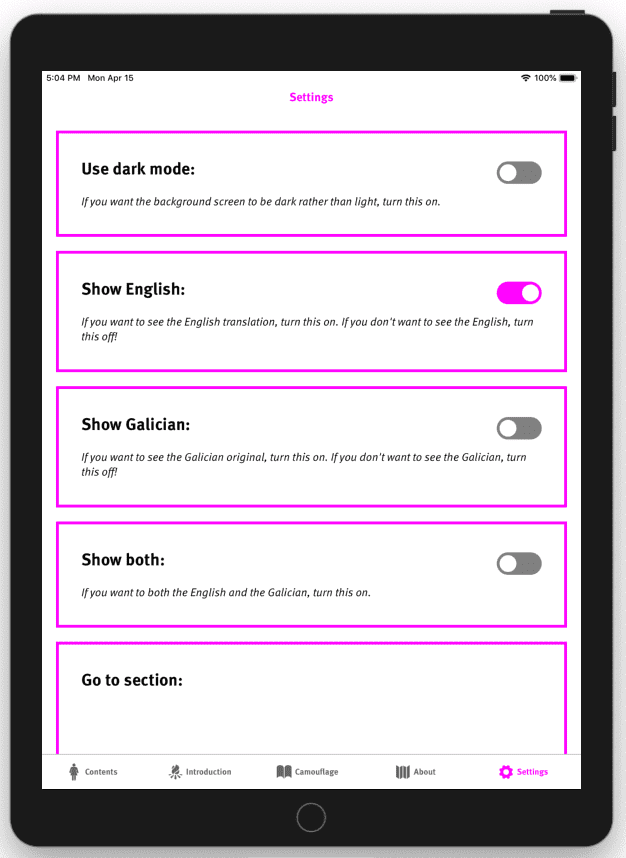
Also, for good measure, there's a settings page.
It's coming along! Any day now. This is being done in something called ReactNative, which will let us make both Android and iOS apps; and while the experience will probably be better on a tablet than a phone, it should work on phones too. If you're interested in beta testing, let me know? Potential Android tablet users would be particularly useful!
How does a book get made?
Making a book can be a complicated process involving a lot of people. In our case, it takes place all over the world. Here’s a diagram that explains exactly how it happened!
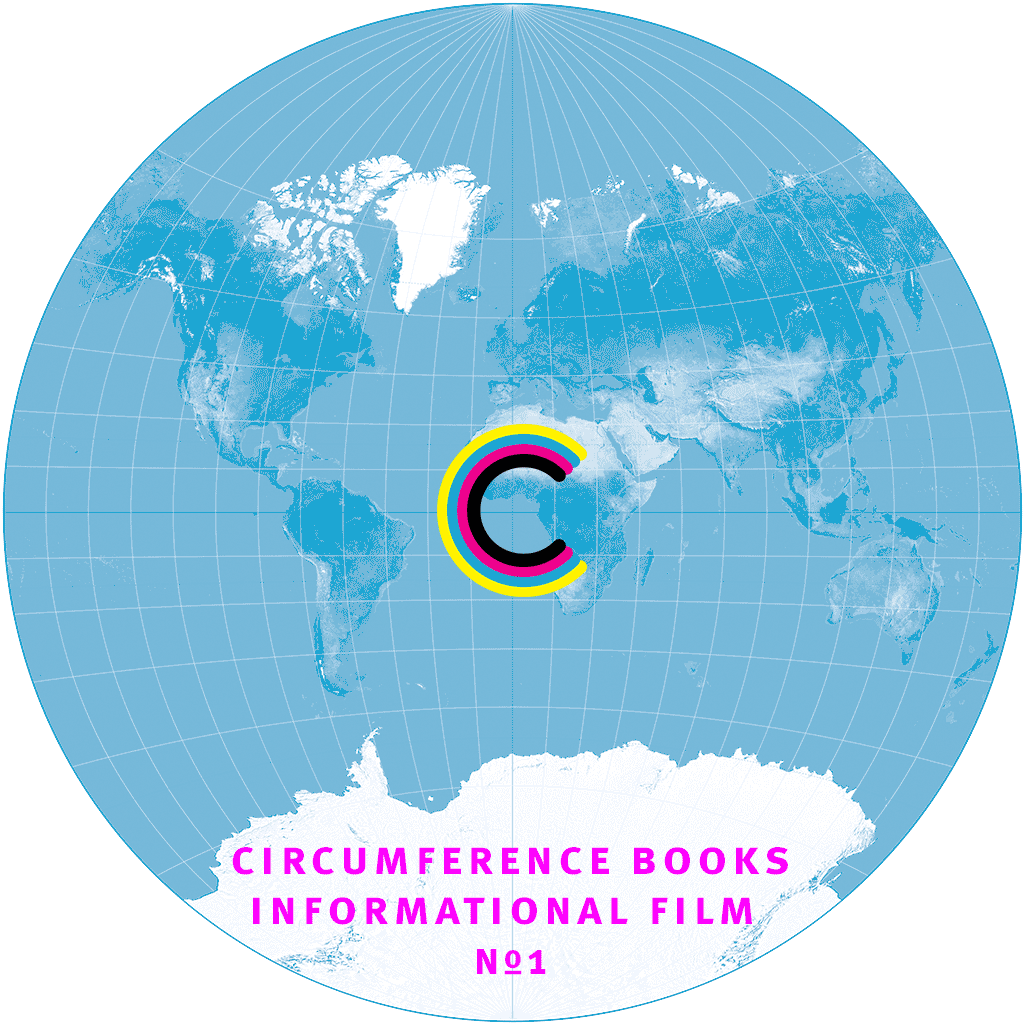
Proust Questionnaire: Lupe Gómez
Original in Galician on Ramón Nicolás’s highly respected literary blog, Caderno da Crítica [Critical Notebook]. Translated by Erín Moure.
1. What is your most obvious character trait?
I’m very steadfast. I have a great capacity for concentration. Never do I abandon words. Words never abandon me. I always seek Silence, spaces of calm. I’m continually inspired. Every night, inspiration goes to sleep on the roof of my house.
2. What quality do you most appreciate in a person?
Loyalty. I really appreciate people who are straightforward, real and true as bread fresh out of the oven. Without masks or tricks. Waters that run clear in the channels. It makes it easier to understand each other and create lasting relationships.
3. What do you most value in your friends?
That they are loyal and understand me even when I vanish or don’t wish to laugh, dance, be very social. I love mailing or emailing my writings to my friends and am delighted when they read me with excited complicity, in that impulse and euphoria that brings us close and yet lets us fly, break free…
4. What is the trait you most deplore in yourself?
I admit that I’m fairly vulnerable, very demanding of myself, of writing, and also of those who surround and love me. My family and friends are aware of this and take it into account. I try to be more flexible, more understanding of imperfection, try to accept life as it is, love myself and let the winds blow where they will, in the secret freedom of the human condition.
5. What is your favourite activity?
Writing letters with all the passion in the world. Let my poetic secrets flow onto the page whether white or multi-coloured. Wrapping the letter in gift paper, writing addresses on envelopes, sticking stamps on the envelopes as if they were honeyed kisses. Heading to the post office on my blue bicycle; it’s my way of travelling the world, full as a bird with surprises.
6. What makes you most happy?
Writing and receiving letters. I love revitalizing the old custom of letter-writing, so noble, exceptional, and right. The epistolary genre is my favourite of all. One day my letters will appear as a book with Alvarellos. Normally publishers are only interested in volumes of letters by people who are dead, but I’m still alive, and have blood, words and frank feelings to share.
7. What is your greatest regret?
That there is no longer any bus to my village, Fisteus. Having to close up the family home, our nest of music, forever, as a result. Not being able to easily visit my parents in their graves. Not being able to share beautiful words with the village world that feeds me so much electricity and makes me who I am.
8. If you were return after death as someone or something, what would it be?
Back in high school at the Instituto Zalaesta, far off in the city of A Coruña, I read One Million Cowsby Manuel Rivas on the sly. My dream was to become a writer and journalist. To join that “world” in which Rivas was a teacher and towering example. Today, he is my mentor and friend. And I still feel as I did when I was fifteen years old, avid to learn . . .
9. Where would you most like to live?
I’ve been on the Rúa Basquiños in Santiago de Compostela for almost twenty years. A whole lifetime, really. In that time, I’ve written twenty books. I’d like to live here another twenty years; with my house and garden, I’m firmly rooted in the cartography of this place.
10. Your favourite colour?
Blue. To me every day is the colour blue.
11. The flower you love best?
The camelia, because it’s tough and embattled, but also very delicate. There’s a camelia tree in my garden, and its flowers are with me from December to March. They don’t realize it but they take part in all my paintings and calligraphy.
12. The bird you are most fond of?
Blackbirds. I adore wrens too, and all tiny birds. The smaller they are, the more I love them. I always draw birds. I find it easy to talk to them, and to understand their language. As a child, I listened to the cuckoo in the distance, and it made me dream and imagine, for it’s a furtive bird, mysterious. Always hidden and camouflaged. I never managed to see it. I would have liked to play with it . . .
13. The prose that most attracts you?
I’m fascinated with the Bible, with its clean, clear, terrible, fantastic, brilliant literature. The Old Testament is amazing. I am especially attracted to the Epistles of Saint Paul, the book of Genesis, the Apocalypse. As a lector at the Cathedral of Santiago de Compostela, I use my voice to add a poetic touch to the reading of the Scriptures; it’s like entering “another dimension.” It’s wonderful, a real privilege, an adventure.
14. And in poetry?
There are two books that are cornerstones in a river of joy, patience, and commitment. Do Courel a Compostela [From the Courel to Compostela] by Uxío Novoneyra and Cantares gallegos [Galician Songs] by Rosalía de Castro. For some unknown reason, they travel together with me. They cross paths and constantly jostle each other, giving rise to a strange beauty; it’s a very intimate relation.
15. Your favourite book?
Dos soños teimosos [Of Stubborn Dreams] by Uxío Novoneyra, in which the poet responds to the questions of his friend, the polymath and philosopher Emilio Araúxo. These conversations are a poetic manifesto that kindles and rekindles my life and thinking. I practically know the whole book by heart. I’ve read it so many times that it inhabits me.
16. Who is your favourite fictional hero?
In my creative memory, my grandfather Antonio, who died when I was eleven, passed into the life of fiction and became my hero. A role model I will never forget. We were close friends and he’d secretly give me sips of beer. I called him “my godfather.” Together, we tended the cows in the spaces where they were pastured.
17. Your heroine?
Heidi. She was a cartoon character with whom I identified very strongly when I was a mountain child, and she always made me laugh and cry. To watch her on television was to imbibe the rich and moist soil of the earth itself.
18. What is your favourite music?
Over the last four or five years, my entire literary work is born from, resonates with, and grazes on the music of my dear friend Amancio Prada. It’s one of my great loves, and enchants me with its life-giving, fresh, new waters. I let myself be carried away every evening by his voice I have just finished a new book of poems, entitled No encanto do aire [Entranced by the Air]. All the poems were written in the cathedral in Santiago, inspired by Amancio Prado’s concert in that amazing space in October, 2017.
19. What is your favourite visual artwork?
The painting of Antón Lamazares. I’ve been lucky to meet him and delight in his rich rural language, his elegance, his wild energy and his poetry. I also love Chagall, Luís Seoane, Velázquez, and many others. To me, calligraphy is a form of painting, very basic, rudimentary even, very simple but also a great luxury within reach of our hands, a physical act of unsurmountable love.
20. Who is your real-life hero?
My aunt Lucita. She’s been in a wheelchair since she was 18. She’s now 80 and still savours life as if it were an aria of roses. She’s never given up. Always has smiles and wise life advice. She’s just finished writing her impressive memoirs, Nubes Bordadas [Embroidered Clouds]. She’s very intelligent, and taught me to read very young. She’s a seamstress of deep affects.
21. What is your favorite name?
Loaira. A name out of Novoneyra’s poetry. I’ve always loved its sonority. To me, it’s a dreamy name, very feminine and elegant.
22. What is the trait you most deplore in others?
I’m a person of few words. I express myself with silences and gestures. Because of this, I can’t stand charlatanism, constant blabbing, talk for the sake of talking, verborrhea. In my mind, people, politicans, priests, journalists, women, youtubers, and everyone, really, talks too much. It is as if words spill out in a rush and lose their original meaning, their weight, their importance and value.
23. What is it that you most dislike?
The sheer noisiness of the society in which we live. Sometimes it makes it impossible to stop and reflect. It torments the ears and causes damage to the heart.
24. Which historical figure do you most despise?
No one in particular. I figure that all historical figures are necessary parts of the incomplete puzzle that is injustice, discord, and wars. I despise people who put themselves above others, those who are corrupt, those who steal, those who cause this world to be less than the clean ring of a guitar.
25. A military feat/deed you admire?
I’m not of a military bent. I don’t know how to explain it. I admire art, invention, popular cultures, but military feats are not part of my imaginary. I admire the Galician women who have laboured non-stop since forever so that History is not just a wreck beached on the sands.
26. What talent would you most like to have?
The gift of laughter. Of graceful wit. A childlike innocence. The capacity to see and feel all the absurd threads that make life move. The subversion of language.
27. How would you like to die?
Peacefully. Very softly and quietly. Writing surrealist poetry so as to understand and embrace my own death, and embark on it.
28. What is your most usual state of mind?
I always feel full of life, with tons of energy, and in good physical shape. When I go out and walk, I feel animated and content. I forget all the pain, the disappointments, the dramatic shocks of the television news.
29. What faults are you most willing to tolerate in others?
I believe I’m very indulgent, compassionate. Compassion is a tenderness that I learned long ago from gazing into the eyes of cows. Those animals are my goddesses, my Buddhist teachers.
30. Do you have a proverb or motto that guides you?
There’s always another poem to write. A new day always brings us new words.
(June 2018, translated August 2018. Used with the permission of Ramón Nicolás.)
Circumference Books in Poets & Writers
Marwa Helal wrote a very nice piece in the January/February 2019 issue of Poets & Writers about Circumference Books. Thanks!